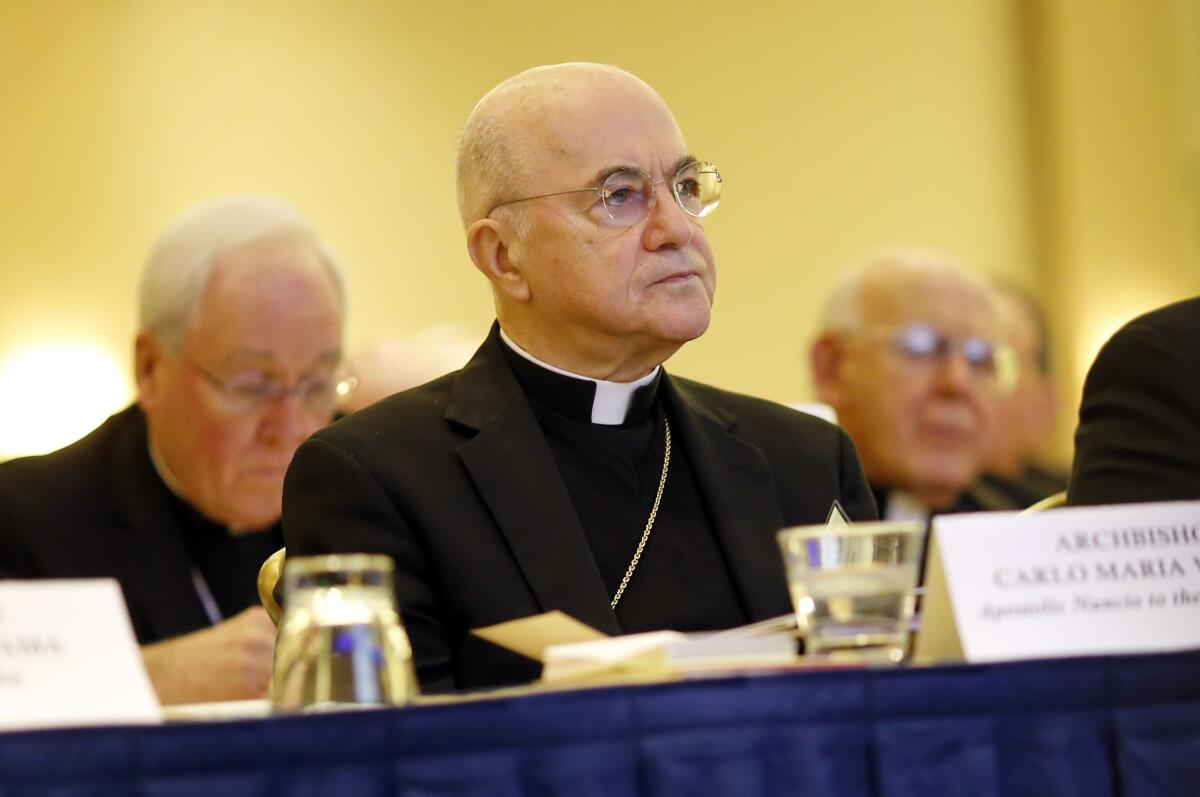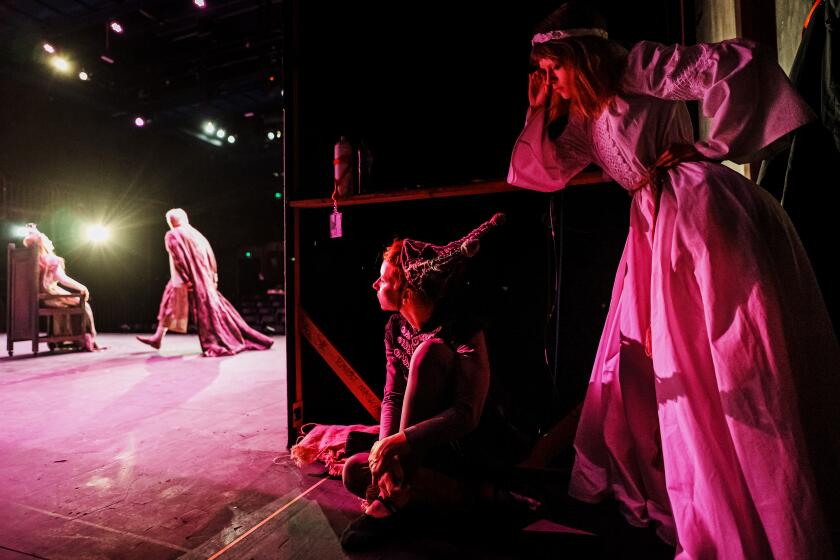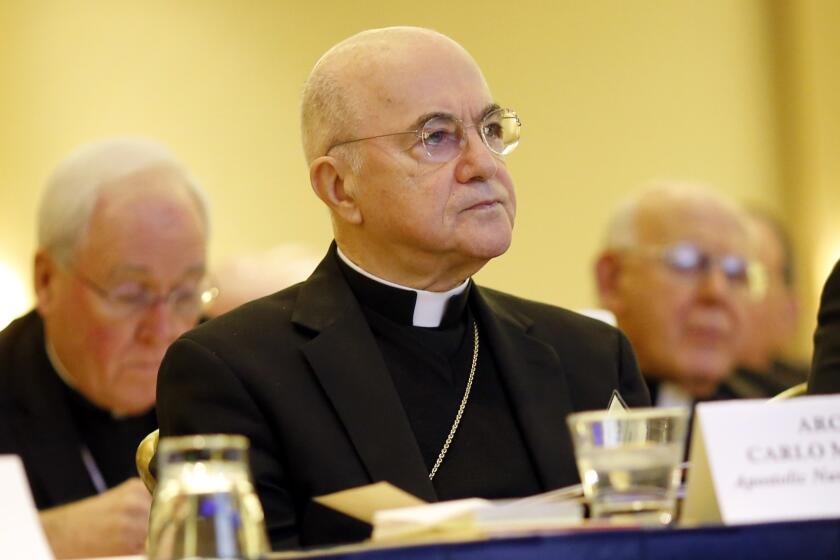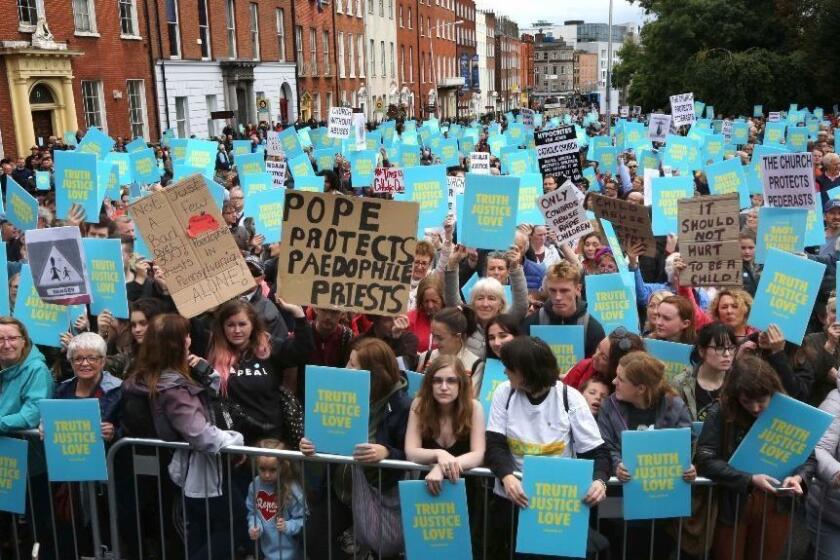Vatican excommunicates conservative former ambassador to U.S., declares him guilty of schism

- Share via
ROME — The Vatican on Friday excommunicated its former ambassador to Washington after finding him guilty of schism, an inevitable outcome for Archbishop Carlo Maria Vigano. The conservative had become one of Pope Francis’ most ardent critics and a symbol of the polarized Catholic Church in the United States and beyond.
Although he once enjoyed support in the Vatican and U.S. church hierarchies, the Italian archbishop alienated many as he developed a fringe following while delving deeper into conspiracy theories on everything — from the coronavirus pandemic to what he called the “Great Reset” and Russia’s war on Ukraine.
The Vatican’s doctrine office announced the penalty after a meeting of its members Thursday and informed Vigano of its decision Friday. It cited Vigano’s public “refusal to recognize and submit to the Supreme Pontiff, his rejection of communion with the members of the church subject to him, and of the legitimacy and magisterial authority of the Second Vatican Council.”
Ukrainians displaced by war find new purpose in Shakespeare’s play of love, loss and madness, bringing their blood-red version to the bard’s hometown.
The excommunication, which Vigano incurred automatically with his positions, means he is formally outside communion with the church and cannot celebrate or receive its sacraments. The crime of schism occurs when someone withdraws submission to the pope or from the communion of Catholics who are subject to him.
Unlike defrocking, a punitive measure that makes a priest a layman again, excommunication is considered a “medicinal” penalty and is declared in hopes that those who incurred it would repent and come back into communion. If that happens, the Holy See can lift the penalty.
Schisms, which have been regular in the church’s 2,000-year history, are considered particularly dangerous as they threaten the unity of the church.
Vigano’s dire pronunciations about the current state of the church, amplified on Catholic social media and by ideologically friendly bloggers on both sides of the Atlantic, were an exaggerated version of the chasm between U.S. ultra-conservatives and Francis. And although Vigano enjoyed mainstream support among bishops early in his career, many quietly distanced themselves as his ideas became more extreme.
The Italian prelate, who has not been seen publicly since before 2018, knew the schism declaration was coming after the Vatican informed him of the penal process launched against him last month. He defiantly called it “an honor” and refused to appear in person or defend himself or submit a written defense.
On June 20, Vigano issued a lengthy public statement refusing to recognize the authority of the Vatican’s doctrinal office “that claims to judge me, nor of its prefect, nor of the one who appointed him.” He did not directly respond to the schism declaration on Friday on X, his usual forum.
The Roman Catholic Church went into crisis mode this week after a Vatican official published an 11-page letter alleging that Pope Francis and U.S.
Vigano burst onto the public scene in 2012, during the first so-called Vatileaks scandal, when Pope Benedict XVI’s butler leaked the pontiff’s private papers to an Italian journalist to try to draw attention to corruption in the Holy See.
In some of the leaked letters, Vigano, then the No. 2 in the Vatican City State administration, begged the pope not to be transferred after exposing corruption in the awarding of Vatican contracts that cost the Holy See millions of dollars.
The entreaties did not work. By the time the letters were published, Vigano was appointed the Vatican’s ambassador to the U.S. — a prestigious post but one that took him far from Rome and out of the running to one day be a cardinal.
Vigano reappeared on the scene during Francis’ 2015 visit to the U.S., which as nuncio he helped organize. Everything was going fine until Vigano arranged for Kim Davis, a Kentucky clerk at the center of the U.S. gay marriage debate, to be present at the Vatican residence to greet Francis, along with many other people.
After the visit, Davis and her lawyers claimed the encounter with Francis amounted to an affirmation of her cause denying marriage licenses to same-sex couples. The Vatican later turned the tables on Davis’ claim, saying that she had merely been among a group of well-wishers and that the “only” private audience Francis had in Washington was with a small group of people that included a gay couple.
Vigano’s deception in inviting Davis to meet the pope put the prelate and the pontiff on a collision course that exploded in August 2018.
At the time, the U.S. church was reeling from a new chapter in its clergy sex abuse scandal: One of the most senior U.S. churchmen, Cardinal Theodore McCarrick, was accused of molesting a minor and a Pennsylvania grand jury issued a devastating investigation into decades of abuse and cover-up.
As Francis was wrapping up a tense visit to Ireland, Vigano published an 11-page screed accusing him and a long string of U.S. and Vatican officials of covering for McCarrick. Specifically, Vigano accused Francis of rehabilitating McCarrick from sanctions imposed by Pope Benedict, and called on him to resign — accusations that created the greatest crisis of Francis’ then-young pontificate.
In a remarkable and scathing recrimination, the Vatican’s former ambassador to Washington accused Pope Francis and his predecessor Pope Benedict XVI on Sunday of knowingly hiding sexual abuse allegations involving a now-disgraced American cardinal, further convulsing a church in crisis.
Francis quickly authorized an in-house investigation into McCarrick. The report, released in 2020, confirmed that a generation of church officials, including Pope John Paul II, had turned a blind eye to McCarrick’s misconduct. It largely spared Francis, who eventually defrocked the churchman.
But the report also faulted Vigano for not looking into new claims against McCarrick or enforcing Vatican restrictions on him when specifically ordered to do so by the Vatican.
At that point, Vigano’s claims against Francis became more extreme, endorsing conspiracy theories about the coronavirus vaccines, appearing at far-right U.S. political rallies via video, backing Russia in its war on Ukraine, and eventually, refusing to recognize Francis as pope.
Massimo Faggioli, a theologian at Villanova University, said that although a good number of U.S. bishops vouched for Vigano’s integrity when he first made his claims about McCarrick in 2018, his declarations in the ensuing years “led some of them to more prudent positions.”
In an essay in the French daily La Croix, Faggioli also noted that Vigano had had a seeming unintended effect of mainstreaming another schismatic group, the Society of St. Pius X, which also rejects the reforms of the Second Vatican Council, the 1960s meetings that modernized the church.
However, the society known as SSPX, founded by the late French Archbishop Marcel Lefebvre in 1969, distanced itself from Vigano and his rejection of the legitimacy of Francis’ pontificate, saying it has “not ventured down that perilous road.”
Vigano’s positions make Lefebvre and the SSPX “look like right-of-center Catholics, and not like the extreme traditionalists they actually are,” Faggioli wrote. “This says something about the ground shifting under the feet of Vatican II Catholics.”
Winfield writes for the Associated Press.
More to Read
Sign up for Essential California
The most important California stories and recommendations in your inbox every morning.
You may occasionally receive promotional content from the Los Angeles Times.













